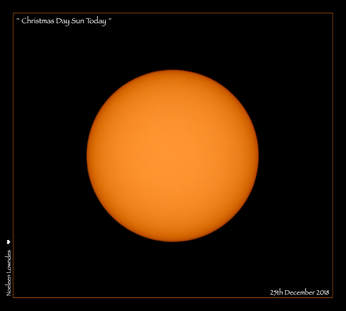Our beautiful Sun today on Christmas Day after weeks and weeks of rain and thunderstorms…Merry Christmas to all and happy holidays!
I just had to add a Santa hat to our very bland Sun for fun :-)
Image taken with a Canon 70D camera and a Tamron 18-400mm lens with a 2x teleconverter attached, a glass solar filter was fitted to the lens for safe viewing and imaging. Exposure time was 1/500th second and ISO200.

The Sun is now experiencing a period of solar minimum with over 200 days this year without sunspots on its surface, gone are the days when so much activity could be see on the surface of the Sun…I really miss all the excitement!
The image (left and above) of the Sun that I took on Christmas Day is completely bland and spotless!
To safely take images of the solar surface you must always use a solar filter on the lens of your camera or telescope. I haven’t even used my Lunt 60mm (Ha) solar telescope much this year as the Sun has been very quite in this H-alpha wavelength as well.
But there has been another type of activity on the Sun that’s quite intriguing, and that is these corona holes that open up and expel subatomic solar particles throughout the solar system. They are not as powerful as a CME but they still produce some awesome aurora when they hit our atmosphere.
When these solar particles hit the oxygen and nitrogen in our Earths atmosphere they excite the gases and release a photon of light that produces the coloured curtains of light of the auroras.
It was one of these incredible episodes that produced the stunning northern lights (Aurora Borealis) that my husband and I witnessed in March 2018 when we were on board the Hutigruten ship called the Nordkapp that cruised up and down the Norwegian coastline. Wow…what a magical experience that was!!!!
My aurora image won a David Malin award this year in the Nightscapes section. If you go to the link you will see my picture and all the other stunning astronomy images that won awards this year at: https://www.parkes.atnf.csiro.au/news_events/astrofest/awards/



 RSS Feed
RSS Feed
